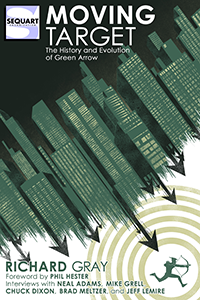Sometimes, maybe all the time, compelling narrative storytelling is about constantly raising the stakes. For a book that started with the destruction of a major human civilization, Descender has fairly masterfully managed to raise the stakes each and every outing, each step taking its readers closer to the central question of the text: What was it about the codex that brought about the Harvester invasion? We received a big part of the answer in the previous issue, #6, which revealed that it was part of some ancient civilization that had undergone a similar “robot vs human” conflict, which didn’t end well. But the central conflict obviously still isn’t over, and TIM-21 and his friends have been caught up in the nastiest form of the conflict still in operation. Where they once moved in the land of organized government and military strategy, they find themselves now in the realm of bounty hunters and extremist militias, all of which serve to make the story more intense, more dramatic and even more Star Wars-esque than before.
The resemblance to Star Wars isn’t any kind of insult: Descender is emphatically its own kind of story, but the setting and the conflicts are obviously inspired by the earlier text. Unlike many comics inspired by the classic space operas, this book takes the style deeper, with more darkly beautiful artfulness, than the original itself. Much of that has to do with Dustin Nguyen’s evolving art style, which reaches a breakthrough here in issue #7, reflecting the book’s rapidly growing confidence in its own universe and visual patina. The opening sequence of the previous issue consisted of some impressive desert landscapes, but still seemed to have a tentative touch, as if the creators thought they were making a TV show, rather than a feature film. But that hesitation is gone here in issue #7. From the beautiful snowy landscapes, rendered in Nguyen’s subtle, shaded style, starting with a deliberately rectangular frame at the classic 2:35:1 aspect ratio, to the two-page splash of the title set boldly against a starscape, this issue is where Descender goes for broke, and embraces the cinematic sensibility it’s always deserved.
Nguyen’s work here has depth, but his backgrounds are done with subtlety that it registers on an almost subliminal level. The first panels, and particularly the first big splash page featuring a bounty hunter carrying heads away from killing site, reach Ridley Scott-levels of deep focus and textured smoke. In fact, one could argue that his work even surpasses Sir Ridley at times, taking advantage of the possibilities of comics not available to the physical laws of filmmaking. Even in dialogue scenes set in smaller places later on, the backgrounds seem almost expressionistic, and all the more effective for them.
In terms of story, here we have to deal with the introduction of TIM-22, the brother of our central character TIM-21. TIM-21 was, from the start, a likeable and relatable robot character, cut from the cloth of any number of Disney heroes. Smart but innocent, tough but still a child, he was both our eyes into the story and a way to give the universe scale. To a child, everything seems bigger, so telling this story from his perspective was inspired. But TIM-22 gives us the opposite number, and reminds us that both of these boys are actually robots, and capable of inflicting suffering without any remorse or guilt. It’s all a matter of programming. They both, of course, seem to be considered important, and seem to carry the essential codex, so much so that they have been passed from government-based agents (Captain Telsa), to the anti-robot fanatics on Gnish, and this time to anti-human fanatics, who of course are robots. In addition, we have the introduction of the robot bounty hunter, collecting the heads of these machines in exchange for cash. Poor TIM-21 is caught up in all of this conflict without really understanding why, but TIM-22 has chosen sides. TIM-21 is fundamentally drawn to the individual personalities of the people he meets, robot or humanoid, and is inclined to like them all, even (or perhaps especially) extreme robots like Driller or Bandit. TIM-22 is quite different, and seems more aware of his power and his place in the galaxy, giving him a chilling, almost Damien-like quality, of a young boy with more intelligence and knowledge than he should possess.
This, of course, is only the beginning of a new arc in the story of Descender, titled “Machine Moon”, and the story is just getting started. The introduction of a new major character at the end of this issue only deepens the story of TIM-21 and raises the emotional stakes. Descender has succeeded magnificently in raising the scale of the story while simultaneously narrowing the character focus: a difficult task in any medium. That skillful storytelling, and realistic child characters (we expect no less from Jeff Lemire), combined with powerful and virtuoso comics art, should grow its fan base along with its aspect ratio. It’s become an essential title for any fan of adventure science fiction.






























































